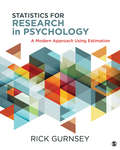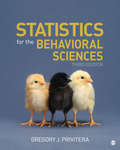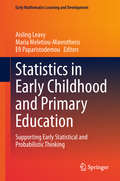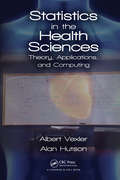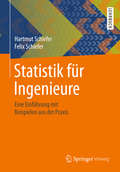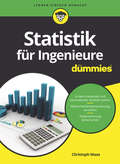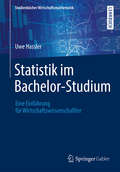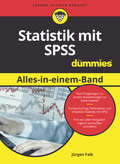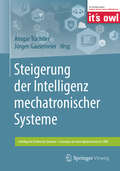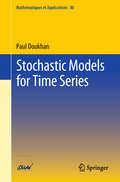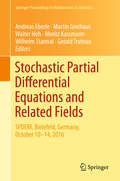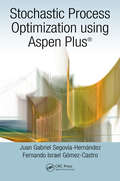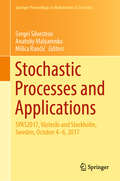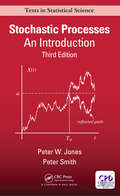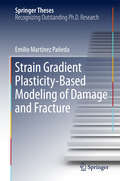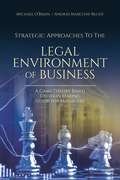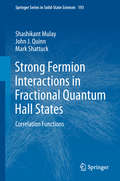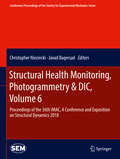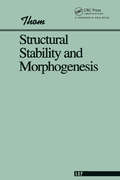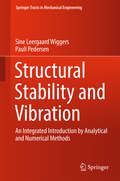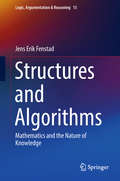- Table View
- List View
Statistics for Research in Psychology: A Modern Approach Using Estimation
by Rick GurnseyStatistics for Research in Psychology by Rick Gurnsey offers an intuitive approach to statistics based on estimation for interpreting research in psychology. This innovative text covers topic areas in a traditional sequence but gently shifts the focus to an alternative approach using estimation, emphasizing confidence intervals, effect sizes, and practical significance, with the advantages naturally emerging in the process. Frequent opportunities for practice and step-by-step instructions for using Excel, SPSS, and R in appendices will help readers come away with a better understanding of statistics that will allow them to more effectively evaluate published research and undertake meaningful research of their own.
Statistics for Research in Psychology: A Modern Approach Using Estimation
by Rick GurnseyStatistics for Research in Psychology by Rick Gurnsey offers an intuitive approach to statistics based on estimation for interpreting research in psychology. This innovative text covers topic areas in a traditional sequence but gently shifts the focus to an alternative approach using estimation, emphasizing confidence intervals, effect sizes, and practical significance, with the advantages naturally emerging in the process. Frequent opportunities for practice and step-by-step instructions for using Excel, SPSS, and R in appendices will help readers come away with a better understanding of statistics that will allow them to more effectively evaluate published research and undertake meaningful research of their own.
Statistics for the Behavioral Sciences
by Dr Gregory J. PriviteraThe engaging Third Edition of Statistics for the Behavioral Sciences shows students that statistics can be understandable, interesting, and relevant to their daily lives. Using a conversational tone, award-winning teacher and author Gregory J. Privitera speaks to the reader as researcher when covering statistical theory, computation, and application. Robust pedagogy allows students to continually check their comprehension and hone their skills when working through carefully developed problems and exercises that include current research and seamless integration of SPSS. This edition will not only prepare students to be lab-ready, but also give them the confidence to use statistics to summarize data and make decisions about behavior.
Statistics for the Behavioral Sciences
by Dr Gregory J. PriviteraThe engaging Third Edition of Statistics for the Behavioral Sciences shows students that statistics can be understandable, interesting, and relevant to their daily lives. Using a conversational tone, award-winning teacher and author Gregory J. Privitera speaks to the reader as researcher when covering statistical theory, computation, and application. Robust pedagogy allows students to continually check their comprehension and hone their skills when working through carefully developed problems and exercises that include current research and seamless integration of SPSS. This edition will not only prepare students to be lab-ready, but also give them the confidence to use statistics to summarize data and make decisions about behavior.
Statistics in Early Childhood and Primary Education: Supporting Early Statistical and Probabilistic Thinking (Early Mathematics Learning and Development)
by Aisling Leavy Maria Meletiou-Mavrotheris Efi PaparistodemouThis compilation focuses on the theory and conceptualisation of statistics and probability in the early years and the development of young children’s (ages 3-10) understanding of data and chance. It provides a comprehensive overview of cutting-edge international research on the development of young learners’ reasoning about data and chance in formal, informal, and non-formal educational contexts. The authors share insights into young children’s statistical and probabilistic reasoning and provide early childhood educators and researchers with a wealth of illustrative examples, suggestions, and practical strategies on how to address the challenges arising from the introduction of statistical and probabilistic concepts in pre-school and school curricula. This collection will inform practices in research and teaching by providing a detailed account of current best practices, challenges, and issues, and of future trends and directions in early statistical and probabilistic learning worldwide. Further, it will contribute to future research and theory building by addressing theoretical, epistemological, and methodological considerations regarding the design of probability and statistics learning environments for young children.
Statistics in the Health Sciences: Theory, Applications, and Computing (Chapman & Hall/CRC Biostatistics Series)
by Albert Vexler Alan Hutson"This very informative book introduces classical and novel statistical methods that can be used by theoretical and applied biostatisticians to develop efficient solutions for real-world problems encountered in clinical trials and epidemiological studies. The authors provide a detailed discussion of methodological and applied issues in parametric, semi-parametric and nonparametric approaches, including computationally extensive data-driven techniques, such as empirical likelihood, sequential procedures, and bootstrap methods. Many of these techniques are implemented using popular software such as R and SAS."— Vlad Dragalin, Professor, Johnson and Johnson, Spring House, PA "It is always a pleasure to come across a new book that covers nearly all facets of a branch of science one thought was so broad, so diverse, and so dynamic that no single book could possibly hope to capture all of the fundamentals as well as directions of the field. The topics within the book’s purview—fundamentals of measure-theoretic probability; parametric and non-parametric statistical inference; central limit theorems; basics of martingale theory; Monte Carlo methods; sequential analysis; sequential change-point detection—are all covered with inspiring clarity and precision. The authors are also very thorough and avail themselves of the most recent scholarship. They provide a detailed account of the state of the art, and bring together results that were previously scattered across disparate disciplines. This makes the book more than just a textbook: it is a panoramic companion to the field of Biostatistics. The book is self-contained, and the concise but careful exposition of material makes it accessible to a wide audience. This is appealing to graduate students interested in getting into the field, and also to professors looking to design a course on the subject." — Aleksey S. Polunchenko, Department of Mathematical Sciences, State University of New York at Binghamton This book should be appropriate for use both as a text and as a reference. This book delivers a "ready-to-go" well-structured product to be employed in developing advanced courses. In this book the readers can find classical and new theoretical methods, open problems and new procedures. The book presents biostatistical results that are novel to the current set of books on the market and results that are even new with respect to the modern scientific literature. Several of these results can be found only in this book.
Statistik für Ingenieure
by Hartmut Schiefer Felix SchieferDie in diesem Lehrbuch dargestellten Inhalte zeigen anschaulich und verständlich, wie statistische Methoden effektiv in der Arbeit eines Ingenieurs eingesetzt werden können. Die Anwendung statistischer Methoden ermöglicht den Versuchsaufwand zu reduzieren, eine vollständige Auswertung der Versuchsergebnisse und folglich statistisch fundierte Aussagen. Es kann effizienter entwickelt sowie kostengünstiger und prozesssicherer gefertigt werden. Denn allgemeines Ziel ist es, Zeit, Kosten und Material zu sparen. Der praktische Anwendungscharakter wird durch die ausgeführten Beispiele klar erkennbar.
Statistik für Ingenieure für Dummies (Für Dummies)
by Christoph MaasDieses Buch ermöglicht Ihnen auf leicht verständliche Weise den Einstieg in statistische Fragestellungen. In einer einheitlichen Darstellungsweise mit wiederkehrenden Abschnitten "So geht?s", "Darauf kommt es an", "Das steckt dahinter" führt es Sie dann zu fortgeschrittenen Themen wie stochastischen Prozessen oder Zeitreihen. Die Formeln und Rechenverfahren, die Sie beherrschen müssen, werden so vorgestellt, dass Sie sie sofort einsetzen können. Die Beispiele stammen aus unterschiedlichen Gebieten. So sehen Sie auch für Ihr Fach, wie die Methoden dort eingesetzt werden.
Statistik im Bachelor-Studium: Eine Einführung Für Wirtschaftswissenschaftler (Studienbücher Wirtschaftsmathematik Ser.)
by Uwe HasslerDieses Buch umfasst genau den Stoff, der typischerweise in Klausuren zu Einführungsvorlesungen "Statistik" an wirtschaftswissenschaftlichen Fachbereichen abgeprüft wird. Es enthält mehr als 100 ehemalige Klausuraufgaben mit Lösungen auf der Verlagsseite, die das Klausurtraining erleichtern sollen. Weiterhin finden sich über 60 vollständig durchgerechnete und ausformulierte Beispiele und Fallstudien.
Statistik mit SPSS Alles in einem Band für Dummies (Für Dummies)
by Jürgen FaikReale Sachverhalte statistisch zu erschließen und zu analysieren ist eine hohe Kunst. Das Programmpaket SPSS ist dafür ein mächtiges Werkzeug. In diesem Buch lernen Sie anhand zahlreicher Beispiele, welche statistischen Verfahren es überhaupt gibt und wann welches Verfahren angemessen ist. Gleich im Anschluss erfahren Sie, wie diese Verfahren in SPSS implementiert sind und wie Sie sie in Ihrem Fachgebiet nutzen können. So finden Sie Zusammenhänge in Ihren Daten, die statistisch signifikant sind.
Steigerung der Intelligenz mechatronischer Systeme (Intelligente Technische Systeme – Lösungen aus dem Spitzencluster it’s OWL)
by Ansgar Trächtler Jürgen GausemeierDas Buch beschreibt die Ergebnisse des Querschnittsprojekts „Selbstoptimierung“ des vom BMBF geförderten Spitzencluster-Projekts „Intelligente Technische Systeme OstWestfalenLippe“ (kurz: it’s OWL).Die Entwicklung der Informations- und Kommunikationstechnik eröffnet neue Perspektiven für intelligente technische Systeme, die hohen Kundennutzen stiften. Diese Systeme sind in der Lage, sich ihrer Umgebung und den Wünschen ihrer Anwender im Betrieb anzupassen. Für den Innovationssprung von der Mechatronik hin zu selbstoptimierenden Systemen wird Expertise aus den Gebieten Maschinelles Lernen, mathematische Optimierungsverfahren, Regelungstechnik und Condition Monitoring benötigt.Zielsetzung des Cluster-Querschnittsprojekts Selbstoptimierung war ein Instrumentarium zur Planung und Entwicklung von selbstoptimierenden Produkten und Produktionssystemen. Dieses soll die Entwickler in den Unternehmen bei der Realisierung von Ansätzen der Selbstoptimierung praxisgerecht unterstützen. Das vorliegende Buch stellt das erarbeitete Instrumentarium mit den entsprechenden Schwerpunkten im Detail vor. Dabei werden die wesentlichen Grundlagen der jeweiligen Fachgebiete gezeigt und die methodische Umsetzung anhand von Praxisbeispielen aus dem Spitzencluster erläutert.
Stochastic Geometry Analysis of Cellular Networks
by Martin Haenggi Bartłomiej Błaszczyszyn Paul Keeler Sayandev MukherjeeAchieve faster and more efficient network design and optimization with this comprehensive guide. Some of the most prominent researchers in the field explain the very latest analytic techniques and results from stochastic geometry for modeling the signal-to-interference-plus-noise ratio (SINR) distribution in heterogeneous cellular networks. This book will help you understand the effects of combining different system deployment parameters on such key performance indicators as coverage and capacity, enabling efficient allocation of simulation resources. In addition to covering results for network models based on the Poisson point process, this book presents recent results for when non-Poisson base station configurations appear Poisson due to random propagation effects such as fading and shadowing, as well as non-Poisson models for base station configurations, with a focus on determinantal point processes and tractable approximation methods. Theoretical results are illustrated with practical long-term evolution (LTE) applications and compared with real-world deployment results.
Stochastic Models for Time Series (Mathématiques et Applications #80)
by Paul DoukhanThis book presents essential tools for modelling non-linear time series. The first part of the book describes the main standard tools of probability and statistics that directly apply to the time series context to obtain a wide range of modelling possibilities. Functional estimation and bootstrap are discussed, and stationarity is reviewed. The second part describes a number of tools from Gaussian chaos and proposes a tour of linear time series models. It goes on to address nonlinearity from polynomial or chaotic models for which explicit expansions are available, then turns to Markov and non-Markov linear models and discusses Bernoulli shifts time series models. Finally, the volume focuses on the limit theory, starting with the ergodic theorem, which is seen as the first step for statistics of time series. It defines the distributional range to obtain generic tools for limit theory under long or short-range dependences (LRD/SRD) and explains examples of LRD behaviours. More general techniques (central limit theorems) are described under SRD; mixing and weak dependence are also reviewed. In closing, it describes moment techniques together with their relations to cumulant sums as well as an application to kernel type estimation.The appendix reviews basic probability theory facts and discusses useful laws stemming from the Gaussian laws as well as the basic principles of probability, and is completed by R-scripts used for the figures. Richly illustrated with examples and simulations, the book is recommended for advanced master courses for mathematicians just entering the field of time series, and statisticians who want more mathematical insights into the background of non-linear time series.
Stochastic Partial Differential Equations and Related Fields: In Honor of Michael Röckner SPDERF, Bielefeld, Germany, October 10 -14, 2016 (Springer Proceedings in Mathematics & Statistics #229)
by Martin Grothaus Andreas Eberle Walter Hoh Moritz Kassmann Wilhelm Stannat Gerald TrutnauThis Festschrift contains five research surveys and thirty-four shorter contributions by participants of the conference ''Stochastic Partial Differential Equations and Related Fields'' hosted by the Faculty of Mathematics at Bielefeld University, October 10–14, 2016. The conference, attended by more than 140 participants, including PostDocs and PhD students, was held both to honor Michael Röckner's contributions to the field on the occasion of his 60th birthday and to bring together leading scientists and young researchers to present the current state of the art and promising future developments.Each article introduces a well-described field related to Stochastic Partial Differential Equations and Stochastic Analysis in general. In particular, the longer surveys focus on Dirichlet forms and Potential theory, the analysis of Kolmogorov operators, Fokker–Planck equations in Hilbert spaces, the theory of variational solutions to stochastic partial differential equations, singular stochastic partial differential equations and their applications in mathematical physics, as well as on the theory of regularity structures and paracontrolled distributions.The numerous research surveys make the volume especially useful for graduate students and researchers who wish to start work in the above-mentioned areas, or who want to be informed about the current state of the art.
Stochastic Process Optimization using Aspen Plus®
by Juan Gabriel Segovia-Hernández Fernando Israel Gómez-CastroStochastic Process Optimization using Aspen® Plus Bookshop Category: Chemical Engineering Optimization can be simply defined as "choosing the best alternative among a set of feasible options". In all the engineering areas, optimization has a wide range of applications, due to the high number of decisions involved in an engineering environment. Chemical engineering, and particularly process engineering, is not an exception; thus stochastic methods are a good option to solve optimization problems for the complex process engineering models. In this book, the combined use of the modular simulator Aspen® Plus and stochastic optimization methods, codified in MATLAB, is presented. Some basic concepts of optimization are first presented, then, strategies to use the simulator linked with the optimization algorithm are shown. Finally, examples of application for process engineering are discussed. The reader will learn how to link the process simulator Aspen® Plus and stochastic optimization algorithms to solve process design problems. They will gain ability to perform multi-objective optimization in several case studies. Key Features: • The book links simulation and optimization through numerical analyses and stochastic optimization techniques • Includes use of examples to illustrate the application of the concepts and specific guidance on the use of software (Aspen® Plus, Excel, MATLB) to set up and solve models representing complex problems. • Illustrates several examples of applications for the linking of simulation and optimization software with other packages for optimization purposes. • Provides specific information on how to implement stochastic optimization with process simulators. • Enable readers to identify practical and economic solutions to problems of industrial relevance, enhancing the safety, operation, environmental, and economic performance of chemical processes.
Stochastic Processes and Applications: SPAS2017, Västerås and Stockholm, Sweden, October 4-6, 2017 (Springer Proceedings in Mathematics & Statistics #271)
by Anatoliy Malyarenko Sergei Silvestrov Milica RančićThis book highlights the latest advances in stochastic processes, probability theory, mathematical statistics, engineering mathematics and algebraic structures, focusing on mathematical models, structures, concepts, problems and computational methods and algorithms important in modern technology, engineering and natural sciences applications.It comprises selected, high-quality, refereed contributions from various large research communities in modern stochastic processes, algebraic structures and their interplay and applications. The chapters cover both theory and applications, illustrated by numerous figures, schemes, algorithms, tables and research results to help readers understand the material and develop new mathematical methods, concepts and computing applications in the future. Presenting new methods and results, reviews of cutting-edge research, and open problems and directions for future research, the book serves as a source of inspiration for a broad spectrum of researchers and research students in probability theory and mathematical statistics, applied algebraic structures, applied mathematics and other areas of mathematics and applications of mathematics.The book is based on selected contributions presented at the International Conference on “Stochastic Processes and Algebraic Structures – From Theory Towards Applications” (SPAS2017) to mark Professor Dmitrii Silvestrov’s 70th birthday and his 50 years of fruitful service to mathematics, education and international cooperation, which was held at Mälardalen University in Västerås and Stockholm University, Sweden, in October 2017.
Stochastic Processes: An Introduction, Third Edition
by Peter Smith Peter Watts JonesBased on a well-established and popular course taught by the authors over many years, Stochastic Processes: An Introduction, Third Edition, discusses the modelling and analysis of random experiments, where processes evolve over time. The text begins with a review of relevant fundamental probability. It then covers gambling problems, random walks, and Markov chains. The authors go on to discuss random processes continuous in time, including Poisson, birth and death processes, and general population models, and present an extended discussion on the analysis of associated stationary processes in queues. The book also explores reliability and other random processes, such as branching, martingales, and simple epidemics. A new chapter describing Brownian motion, where the outcomes are continuously observed over continuous time, is included. Further applications, worked examples and problems, and biographical details have been added to this edition. Much of the text has been reworked. The appendix contains key results in probability for reference. This concise, updated book makes the material accessible, highlighting simple applications and examples. A solutions manual with fully worked answers of all end-of-chapter problems, and Mathematica® and R programs illustrating many processes discussed in the book, can be downloaded from crcpress.com.
Strain Gradient Plasticity-Based Modeling of Damage and Fracture
by Emilio Martínez PañedaThis book provides a comprehensive introduction to numerical modeling of size effects in metal plasticity. The main classes of strain gradient plasticity formulations are described and efficiently implemented in the context of the finite element method. A robust numerical framework is presented and employed to investigate the role of strain gradients on structural integrity assessment. The results obtained reveal the need of incorporating the influence on geometrically necessary dislocations in the modeling of various damage mechanisms. Large gradients of plastic strain increase dislocation density, promoting strain hardening and elevating crack tip stresses. This stress elevation is quantified under both infinitesimal and finite deformation theories, rationalizing the experimental observation of cleavage fracture in the presence of significant plastic flow. Gradient-enhanced modeling of crack growth resistance, hydrogen diffusion and environmentally assisted cracking highlighted the relevance of an appropriate characterization of the mechanical response at the small scales involved in crack tip deformation. Particularly promising predictions are attained in the field of hydrogen embrittlement. The research has been conducted at the Universities of Cambridge, Oviedo, Luxembourg, and the Technical University of Denmark, in a collaborative effort to understand, model and optimize the mechanical response of engineering materials.
Strategic Approaches to the Legal Environment of Business: A Game Theory Based Decision Making Guide for Managers
by Michael O'Brien András Margitay-BechtCurrent and future managers are regularly confronted with decisions that create risk in the legal environment of business. This book provides a framework for qualifying legal risk and then determining if the legal risk is worth taking. This framework begins by looking at the relationship between the firm, its suppliers, customers, owners, agents, and others in society as a whole to understand specific risks in personal injury, agreements, products, borrowing money, employees, independent contractors, and business entity selection. When the manager is aware of the magnitude of the risk and the likelihood of the risk, the manager is in a strong position to determine if the risk is worth taking. This book uses numerous applications from Game Theory to determine how risks of the firm compare to risks of another firm, an employee, a vendor and a customer.°Students of business law will appreciate the black letter legal discussions of civil procedure, torts, contracts, the sale of goods, secured transactions, agency, and business associations with tax implications. Aspiring accounting students will find familiarity with many topics that appear on the AICPA exam. Managers will gravitate toward specific guidance with regard to setting up agreements with customers and vendors, creating effective human relations policies, and mitigating firm risks with regard to internal and external stakeholders. Dozens of managers provided input and experience that found its way into the selection of examples in the book ensuring real-world application for many practical business law problems.
Strong Fermion Interactions in Fractional Quantum Hall States: Correlation Functions (Springer Series In Solid-state Sciences Ser. #193)
by John J. Quinn Shashikant Mulay Mark ShattuckThis monograph presents an intuitive theory of trial wave functions for strongly interacting fermions in fractional quantum Hall states. The correlation functions for the proposed fermion interactions follow a novel algebraic approach that harnesses the classical theory of invariants and semi-invariants of binary forms. This approach can be viewed as a fitting and far-reaching generalization of Laughlin’s approach to trial wave functions. Aesthetically viewed, it illustrates an attractive symbiosis between the theory of invariants and the theory of correlations. Early research into numerical diagonalization computations for small numbers of electrons shows strong agreement with the constructed trial wave functions.The monograph offers researchers and students of condensed matter physics an accessible discussion of this interesting area of research.
Structural Health Monitoring, Photogrammetry & DIC, Volume 6: Proceedings Of The 36th Imac, A Conference And Exposition On Structural Dynamics 2018 (Conference Proceedings of the Society for Experimental Mechanics Series)
by Christopher Niezrecki Javad BaqersadStructural Health Monitoring Photogrammetry & DIC, Volume 6: Proceedings of the 36th IMAC, A Conference and Exposition on Structural Dynamics, 2018, the sixth volume of nine from the Conference brings together contributions to this important area of research and engineering. The collection presents early findings and case studies on fundamental and applied aspects of Structural Health Monitoring & Damage Detection, including papers on:Structural Health MonitoringDamage DetectionSystem IdentificationActive Controls
Structural Stability And Morphogenesis
by Rene ThomFirst Published in 2018. Routledge is an imprint of Taylor & Francis, an Informa company.
Structural Stability and Vibration
by Sine Leergaard Wiggers Pauli PedersenThis book offers an integrated introduction to the topic of stability and vibration. Strikingly, it describes stability as a function of boundary conditions and eigenfrequency as a function of both boundary conditions and column force. Based on a post graduate course held by the author at the University of Southern Denmark, it reports on fundamental formulas and makes uses of graphical representation to promote understanding. Thanks to the emphasis put on analytical methods and numerical results, the book is meant to make students and engineers familiar with all fundamental equations and their derivation, thus stimulating them to write interactive and dynamic programs to analyze instability and vibrational modes.
Structurally Unstable Quadratic Vector Fields of Codimension One
by Jaume Llibre Joan C. Artés Alex C. RezendeOriginating from research in the qualitative theory of ordinary differential equations, this book follows the authors’ work on structurally stable planar quadratic polynomial differential systems. In the present work the authors aim at finding all possible phase portraits in the Poincaré disc, modulo limit cycles, of planar quadratic polynomial differential systems manifesting the simplest level of structural instability. They prove that there are at most 211 and at least 204 of them.
Structures and Algorithms: Mathematics And The Nature Of Knowledge (Logic, Argumentation And Reasoning Ser. #15)
by Jens Erik FenstadThis book explains exactly what human knowledge is. The key concepts in this book are structures and algorithms, i.e., what the readers “see” and how they make use of what they see. Thus in comparison with some other books on the philosophy (or methodology) of science, which employ a syntactic approach, the author’s approach is model theoretic or structural. Properly understood, it extends the current art and science of mathematical modeling to all fields of knowledge. The link between structure and algorithms is mathematics. But viewing “mathematics” as such a link is not exactly what readers most likely learned in school; thus, the task of this book is to explain what “mathematics” should actually mean. Chapter 1, an introductory essay, presents a general analysis of structures, algorithms and how they are to be linked. Several examples from the natural and social sciences, and from the history of knowledge, are provided in Chapters 2–6. In turn, Chapters 7 and 8 extend the analysis to include language and the mind. Structures are what the readers see. And, as abstract cultural objects, they can almost always be seen in many different ways. But certain structures, such as natural numbers and the basic theory of grammar, seem to have an absolute character. Any theory of knowledge grounded in human culture must explain how this is possible. The author’s analysis of this cultural invariance, combining insights from evolutionary theory and neuroscience, is presented in the book’s closing chapter. The book will be of interest to researchers, students and those outside academia who seek a deeper understanding of knowledge in our present-day society.
